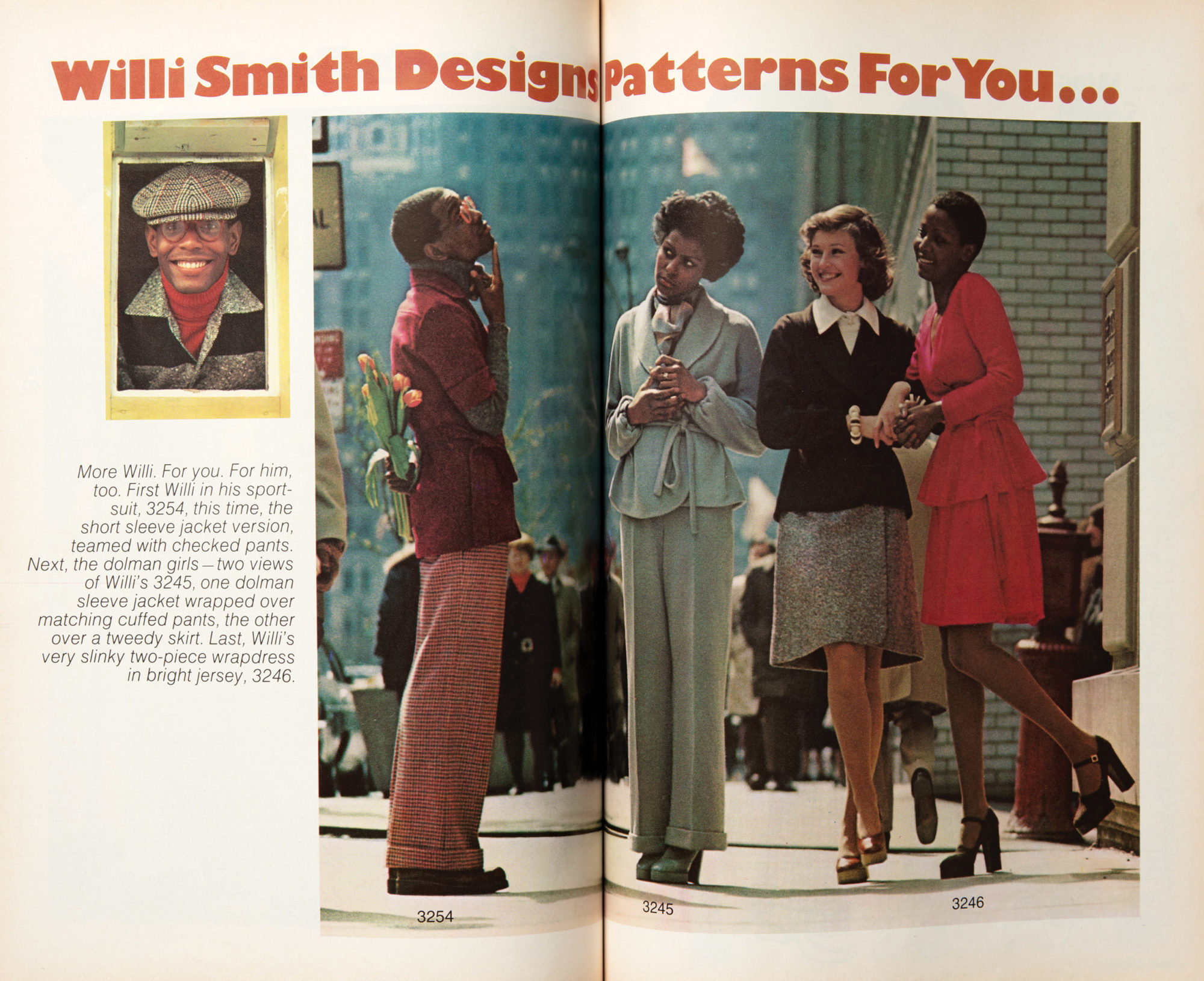As the popularity of home sewing grew in the sixties
and seventies, commercial sewing pattern companies expanded their advertising budgets and invested in alternative promotional techniques, including recruiting celebrity spokespeople and models to promote their patterns. Pattern companies evolved their garment categories to include African-inspired designs, such as the dashiki, and began actively engaging with African American models and designers.1
Willi Smith began designing patterns for Butterick in 1973 while he was still the creative mind behind the sportswear label Digits.2 His first collection published in Butterick’s catalog during the spring of 1973 featured six patterns, including one menswear design that was meant to be replicated in wool for the Fall.3 The collection was also publicized through the July issue of Mademoiselle magazine, a promotional partnership with the Wool Bureau and eight textile mills, as well as through a traveling fashion show featuring variations of each style.4 When Smith designed for Butterick from 1973 to 1981, his patterns were featured alongside the likes of Betsey Johnson and Kenzo in the Young Designers section of each issue. In 1982 when Smith partnered with McCall’s Pattern Company, his designs were extremely similar to his WilliWear collections, comprising billowing, layered pieces for consumers to reproduce. McCall’s integrated the patterns that Smith and his fellow designers created throughout its issues in various sections of the catalogue, further democratizing the designers’ patterns within the company.
In a 1979 interview with On-Ke Wilde for Women’s Wear Daily, Smith said, “There are also a lot of men who sew these days, and I don’t just mean designers,” prefacing how attuned he was to the growing number of male home sewers who used his patterns made for a predominantly female audience.5 Supporting Smith’s claim, Wilde included a brief quote from the design director of Butterick, Diane Vega, adding, “I know that there are men who have used Willi’s patterns for themselves; some of his designs can be used for both sexes.”6 Following the introduction of the first WilliWear menswear collection in 1983, Smith began creating patterns with explicitly gender-fluid designs, a concept already practiced in his runway shows and presentations. Smith’s patterns usually included tailored shirts, blazers, and pants in his characteristic mix of cultural and fashion-historical references, and featured illustrations with male and female figures wearing the same garments.
Smith did not see his sewing patterns for Butterick
and McCall’s as competing with his ready-to-wear collections; rather, he found that the two markets complemented each other.7 Pattern designs were selected and adapted from the previous season’s collection of his ready-to-wear line, fulfilling his desire to expand his brand while also making his clothing even more affordable and accessible.8
Smith respected the home sewers’ awareness of their bodies and willingness to take risks, and saw this audience as more intimately connected to fashion as a means of individual expression than the ready-to-wear shoppers who followed the colors and trends of the runway.9 He understood how choosing the pattern, selecting a custom fabric, and assembling the full garment allowed many possibilities for invention. A dynamic design for a top, for example, allowed sewers to create a blouse, a tunic, and a dress all from a single base pattern.10 Smith, an inherently collaborative spirit, was driven by how pattern design allowed him to share the design process with his consumers.
Luiza Repsold França supported Willi Smith: Street Couture as a Peter A. Krueger Intern at Cooper Hewitt, Smithsonian Design Museum. Originally from Rio de Janeiro, she is a senior at the University of Pennsylvania pursuing a BA in the history of art and minoring in fine art and English with a focus on Latinx culture and the intersection of craft and fine art.
Darnell-Jamal Lisby is a fashion historian and project curatorial assistant at Cooper Hewitt, Smithsonian Design Museum. His contributions to various publications and curatorial efforts explore the art historical context surrounding Blackness and the history of fashion.
- Joy Spanabel Emery, A History of the Paper Pattern Industry: The Home Dressmaking Fashion Revolution (New York: Bloomsbury, 2014), 188–92.
- “Butterick Introducing Willi Smith, ‘Digits’ Collection in the September-dated Catalog,” Fabric News (April 1973).
- Ibid.
- Ibid.
- On-Ke Wilde, “Counter-Points,” Women’s Wear Daily 138, no. 117 (June 19, 1979): 30.
- Ibid.
- Ibid.
- Ibid.
- Ibid.
- Ibid.
























